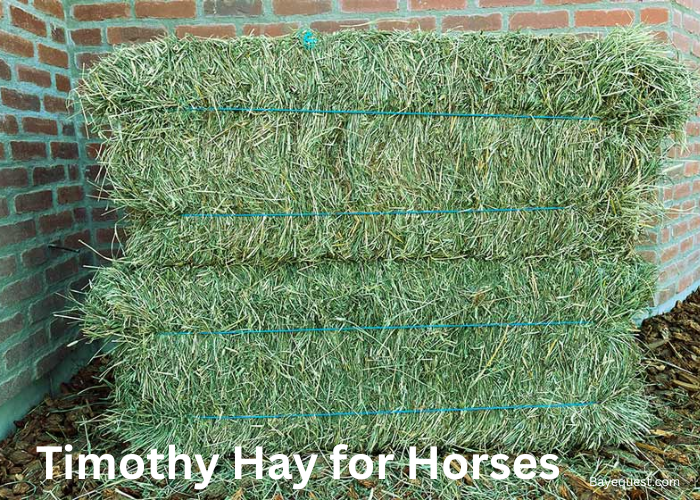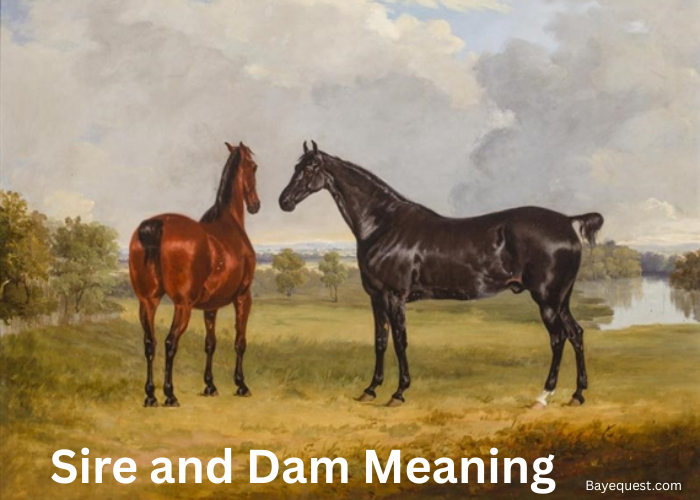If you’ve ever walked into a stable and caught that sweet, earthy smell of fresh hay, chances are you were smelling Timothy hay. It’s one of the most recognizable and trusted feeds for horses around the world.
But with so many different hay types available today, from Alfalfa to orchard grass and Bermuda, many horse owners sometimes wonder: Is Timothy hay really the best option?
In this guide, we’ll explore everything you need to know about Timothy hay. By the end, you’ll know exactly whether Timothy hay is the right choice for your horse – and how to make the most of it.
Timothy Hay for Horses? Key Takeaway
Timothy hay is one of the most trusted and widely used forages for horses. It’s valued for its balanced nutrition, soft texture, and high fiber content. Moreover, it’s gentle on the digestive system and low in sugar, ensuring healthy weight, steady energy, and overall well-being in horses year-round.
What is Timothy Hay?
Timothy hay comes from the perennial grass species Phleum pratense, commonly known as Timothy grass.
It’s a cool-season grass that thrives in temperate climates, especially in North America and parts of Europe.
Known for its fine stems, long seed heads, and soft green leaves, Timothy hay has become a favorite among horse owners. Its consistent quality, balanced nutrition, and natural palatability excite horse owners.
The United States, particularly states like Idaho, Washington, and Oregon, produces some of the finest Timothy hay used both domestically and for export. Canadian Timothy hay is also highly regarded for its clean, leafy texture and fresh scent.
When you look closely at a bale of Timothy hay, you’ll notice its distinctive characteristics. It’s bright green when fresh, with a mild, sweet aroma and a soft, yet slightly fibrous, feel.
The seed heads are elongated and cylindrical, giving them an easily recognizable look compared to other grasses. Meanwhile, the texture and color can vary depending on when it was harvested, how it was dried, and the conditions during growth.

Timothy Hay’s Nutritional Profile
When it comes to horse nutrition, not all hay is created equal. What makes Timothy Hay stand out is its balance. It’s not too rich, not too low in nutrients, and provides exactly what most horses need for steady energy and digestive health.
On average, it contains:
- Crude Protein: 7–11%
- Crude Fiber: 30–35%
- Calcium: 0.4–0.6%
- Phosphorus: 0.2–0.3%
- Digestible Energy: 0.8–0.9 Mcal per pound
These numbers may vary slightly depending on factors such as cutting, growing region, and curing method, but they illustrate one key point: Timothy hay offers moderation.
High fiber, low sugar
Fiber is one of Timothy hay’s greatest strengths. Its high fiber content helps maintain optimal gut motility, which is essential for preventing colic and other digestive upsets.
Just as important, Timothy hay is naturally low in sugars and starches. The stable and predictable sugar levels make it an excellent choice for horses prone to conditions like laminitis, insulin resistance, or Cushing’s disease.
Moderate protein and energy
Unlike Alfalfa, which can reach protein levels above 18%, Timothy hay’s moderate protein content makes it easier on horses that don’t need extra calories. This helps prevent unwanted weight gain or energy spikes in easy keepers, ponies, and leisure horses.
Still, it provides enough nutrition to sustain muscle tone and overall vitality, especially when combined with a balanced grain or supplement program for working or growing horses.
A healthy mineral balance
Timothy hay’s calcium-to-phosphorus ratio is naturally close to 2:1, which is considered optimal for equine diets.
This helps support healthy bones, teeth, and muscles, especially in young or aging horses. The lower calcium content, compared to Alfalfa, also reduces the risk of mineral imbalances or urinary issues in adult horses.
Is Timothy Hay Good for Horses?
Yes, Timothy hay is excellent for horses because it provides balanced nutrition, fiber, and digestibility. It’s low in sugar and moderate in protein, making it safe for most horses, including easy keepers, seniors, and those with metabolic issues.
Above all, its high fiber content supports healthy digestion and steady energy levels.
Benefits of Feeding Timothy Hay to Horses
Timothy hay’s benefits go far beyond simple nutrition. Let’s explore the key reasons why it’s often considered one of the best forages available.
Supports healthy digestion
One of the biggest benefits of Timothy hay is its high fiber content, which helps maintain a healthy digestive system.
Horses are natural grazers. Their digestive tracts are designed for constant intake of roughage.
The fibrous structure of Timothy hay encourages steady chewing and saliva production, which helps buffer stomach acid and reduces the risk of ulcers.
Helps maintain a healthy weight
For horses that tend to gain weight easily, Timothy hay is a perfect match. Its lower calorie and protein levels mean it provides satisfying volume without excessive energy. This allows horses to eat freely without packing on unwanted pounds.
It’s particularly useful for “easy keepers,” ponies, and horses on restricted diets. Because Timothy hay offers bulk and chewing satisfaction, horses can stay occupied and feel full while consuming minimal calories.
Promotes good dental health
Chewing hay isn’t just about digestion – it impacts dental wear and jaw movement. Timothy hay’s long stems and moderate coarseness promote consistent chewing, which helps naturally file down teeth and prevent overgrowth or sharp edges.
For example, Timothy hay works like magic in horses that rely heavily on soft pellets or chopped feeds. It encourages proper grinding motion and saliva flow, both of which are vital for dental and digestive health.
Encourages calm, natural behavior
Horses are herd grazers by instinct. When confined or fed on strict meal schedules, they can develop habits like cribbing, wood-chewing, or stall walking due to boredom or frustration.
Timothy hay helps prevent these behaviors by providing horses with a natural, satisfying activity for many hours each day.
Also, because it’s lower in sugar and energy, it doesn’t cause the “sugar highs” that can make some horses excitable or reactive.
Gentle on the respiratory system
Timothy hay, when properly cured and stored, tends to be less dusty than many other types of grass hay. Moreover, its soft leaves and fine stems make it easier to shake out and feed without sending up clouds of dust.
For horses with sensitive airways or owners who struggle with sneezing or coughing in the barn, soaking or lightly misting Timothy hay before feeding can further reduce airborne particles.
Suitable for almost every horse
One of Timothy Hay’s greatest strengths is its versatility. It works well for nearly all horses, from leisure riders to older retirees.
This explains why horse owners love it. Timothy hay provides enough nutrition to support daily maintenance and light work but remains mild enough for ponies, senior horses, or those with metabolic concerns.
Consistency you can count on
Horse owners appreciate reliability – and that’s exactly what Timothy hay offers. Unlike mixed grass hays, which can vary widely in composition, Timothy hay maintains a consistent nutrient profile year after year.
This makes it easier to plan and balance diets, reducing the guesswork that often comes with changing forage sources.

Which Horses Benefit Most from Timothy Hay?
While Timothy hay can be fed to almost any horse, it’s especially beneficial for certain types and life stages.
Adult horses in light to moderate work
Most mature horses that are ridden lightly, turned out regularly, or used for recreation thrive on a diet centered around Timothy hay.
It provides all the fiber and slow-release energy they need to stay in shape without becoming overweight or overly energetic.
Easy keepers and ponies
If your horse gains weight easily or tends to get “cresty,” Timothy hay is one of the best feeds available.
Its low calorie and sugar levels help prevent obesity and metabolic issues while still satisfying the animal’s need to chew and graze throughout the day. The same applies to ponies and miniature horses.
Senior horses
Older horses benefit greatly from Timothy hay’s soft texture and gentle digestibility, especially when you choose second- or third-cut varieties.
Its balanced calcium-to-phosphorus ratio supports bone health, while the high fiber content keeps digestion smooth and regular.
Horses with metabolic conditions
Horses prone to metabolic issues, such as insulin resistance, Cushing’s (PPID), or a history of laminitis, often require strict control over sugar and starch intake.
Timothy hay is naturally low in non-structural carbohydrates (NSC), which makes it one of the safest options for these horses.
Horses on restricted diets or stall rest
When a horse needs time off due to injury or illness, calorie needs drop, but digestive needs stay the same. Timothy hay provides the bulk and chewing time these horses require without packing on unnecessary weight.
Its steady fiber content helps maintain healthy gut function, even during periods of reduced activity.
How Much Timothy Hay Should You Feed Your Horse?
As a general rule, horses should consume about 1.5% to 2.5% of their body weight in forage each day. For example, a 1,000-pound horse would typically eat between 15 and 25 pounds of hay daily.
Most horses do well right in the middle of that range when fed high-quality Timothy hay. The exact amount, however, depends on several factors, including age, activity level, metabolism, and whether the horse has access to pasture or supplemental feeds.
Here’s what to prioritize;
Weight and body condition
Easy keepers or horses that gain weight quickly should stay closer to the 1.5% recommended range. Meanwhile, hard keepers, senior horses, or those in heavy work may need closer to 2.5%.
The horse’s activity level
For horses on light duties (pleasure riding or pasture turnout), give 1.5 – 2.0% of body weight. Moderate workers (training or in light competition) require 2.0 – 2.25%, while heavy workers (endurance or intense performance) need 2.25 – 2.5% of body weight.
Access to pasture and grain
During the grazing season or if your horse has access to lush pastures, you can reduce the amount of hay you feed.
Conversely, in winter or dry climates where grass is scarce, hay should make up the bulk of their diet.
Feeding method and frequency
How you feed Timothy hay is nearly as important as how much you feed. Split your horse’s total hay ration into at least two or three feedings per day, ensuring no more than 4-6 hours go by without forage.
How to Select Timothy Hay
Choosing high-quality timothy hay is essential to keep your horse healthy, satisfied, and well-nourished. Here’s what to look for:
- Color: Look for bright green hay with a natural sheen. This indicates freshness and high nutrient retention. Avoid hay that looks dull, brown, or yellow, as it’s often old or sun-bleached and may have lost valuable vitamins.
- Smell: Quality hay has a clean, sweet, grassy aroma. A musty or moldy odor is a red flag, suggesting the hay was stored while damp or exposed to moisture. Horses will often refuse hay that smells off.
- Texture: The hay should be soft and pliable, with fine stems and leafy structure. Overly coarse or brittle hay can be difficult to chew and may indicate late harvesting or poor curing.
- Leaf-to-Stem Ratio: The best Timothy hay has a high leaf-to-stem ratio and fewer thick stems. Leaves carry more nutrients than stems, so leafy hay is generally more digestible and flavorful.
- Cleanliness: Always inspect for dust, mold, or foreign matter like weeds, sticks, or insects. Dusty hay can cause respiratory problems, while moldy hay can lead to colic or poisoning.
- Cut Type: Choose the right cut for your horse’s needs – first-cut for more fiber and less richness, or second-cut for softer, more nutrient-dense hay.
Selecting hay with these qualities ensures your horse gets the safest, most nutritious forage possible – fresh, flavorful, and full of the goodness Timothy is known for.
How to Store Quality Timothy Hay
Even the best-quality hay can quickly lose its value or become unsafe if exposed to moisture, pests, or sunlight. Here’s how to store Timothy hay the right way:
- Choose a Dry, Well-Ventilated Area: Store hay in a cool, dry, well-ventilated area to prevent mold growth. Good airflow helps remove moisture and keeps the hay from becoming damp or musty.
- Keep It Off the Ground: Always stack hay on wooden pallets or rubber mats, not directly on the floor. This prevents moisture from the ground from being absorbed, which can lead to mold or spoilage.
- Protect from Sunlight and Rain: Direct sunlight can bleach hay and reduce its vitamin content, while rain or humidity can promote fermentation or mold growth. So, store your hay under a roof or inside a barn with waterproof protection.
- Stack Properly: Avoid over-compressing hay bales. Too-tight stacking can trap heat and increase the risk of spontaneous combustion. Instead, stack them loosely to allow air to circulate between bales.
- Inspect Regularly: Check your hay often for signs of mold, dust, or pests. If you notice a musty smell, discoloration, or insect activity, remove the affected bales immediately to protect the rest.
- Use Older Hay First: Follow a “first in, first out” system. Feed older hay before newer bales to ensure none sits long enough to lose its nutritional quality.

Timothy Hay vs Other Types of Hay
While Timothy hay is a top choice for many horse owners, it’s not the only quality forage available.
Understanding how it compares to other common hay types, such as Alfalfa, orchard grass, and Bermuda hay, can help you make more informed feeding decisions based on your horse’s needs, age, and activity level.
Timothy Hay vs Alfalfa Hay
Alfalfa hay is a legume hay, while Timothy is a grass hay. This distinction makes a big difference in nutritional value.
Alfalfa is significantly higher in protein (around 17–20%) and calcium, making it ideal for young, growing horses and lactating mares. It’s also perfect for hard-working performance horses that require extra nutrients.
However, for easy keepers, senior horses, or those prone to metabolic issues, Alfalfa can be too rich and may contribute to unwanted weight gain or digestive upset.
For more information, check out our other article on the differences between Timothy and Alfalfa hay.
Timothy Hay vs Orchard Grass
Orchard grass is another cool-season grass that’s quite similar to Timothy in appearance and nutrition.
It’s slightly higher in protein (10–12%) and tends to be leafier and softer in texture. Orchard grass can also be more drought-tolerant, meaning it’s often more readily available in certain climates.
Another key difference is palatability. Nutritionally, the two are very close, but some horses prefer orchard grass because it’s sweeter and softer. Timothy has a more fibrous texture.
Read also: Is Orchard Grass Good for Horses?
Timothy Hay vs Bermuda Hay
Bermuda hay, particularly coastal Bermuda, is a warm-season grass hay more commonly grown in southern regions. It’s typically lower in protein (8–10%) and slightly more fibrous than Timothy.
While it’s affordable and widely available, Bermuda hay can sometimes be less digestible, especially if it’s coarse or overmature when harvested. Some horses may also find it less palatable.
That said, high-quality Bermuda hay can be a solid option for horses that need lower-calorie forage, such as easy keepers or horses on restricted diets.
See also: Benefits of Bermuda Hay for Horses.
Timothy Hay vs Mixed Grass Hays
Mixed grass hays vary significantly depending on the blend and growing conditions. Nonetheless, most formulas contain Timothy, orchard, brome, or fescue, among others.
While these blends can be cost-effective and nutritionally balanced, their consistency is the main challenge. You never know exactly what nutrients you’re getting from one bale to the next.
Timothy hay, by contrast, offers predictable quality. Because it’s a single species and widely studied, its nutrient balance is much more reliable.
First-Cut Vs Second-Cut Timothy Hay: Which Is Better?
First-cut Timothy hay is harvested earlier in the growing season and tends to be coarser, with thicker stems and higher fiber content but lower protein.
It’s an excellent choice for easy keepers, overweight horses, or those needing more roughage without too many calories. Its texture also helps promote chewing and proper digestion.
Second-cut Timothy hay, on the other hand, is softer, leafier, and richer in nutrients like protein and fat. Most horses find it more palatable, making it ideal for performance horses, growing foals, or hard keepers that need extra energy.
While both cuts are nutritious, the best choice depends on your horse’s age, workload, and overall dietary needs.
FAQs
Is Timothy hay better than Alfalfa for horses?
It depends on your horse’s needs. Timothy hay is lighter, lower in protein, and great for maintenance or easy keepers. Alfalfa hay, on the other hand, is high in protein and calcium, ideal for growing foals, lactating mares, or high-performance horses.
Can I feed Timothy hay to pregnant mares?
Yes, you can safely feed Timothy hay to pregnant mares. It provides the essential fiber and moderate protein levels needed to support healthy digestion and steady weight gain during pregnancy. Complement it with calcium and protein sources for the best results.
What’s the best way to store Timothy hay?
Keep it dry, elevated, and well-ventilated, away from sunlight and dampness. Stack bales on pallets, not directly on the floor, and rotate stock using the “first in, first out” method. In humid areas, it’s better to buy smaller quantities more frequently to maintain freshness.
Can Timothy hay help with horse allergies?
Yes, though some horses may react to dust or pollen in the hay rather than the hay itself. To minimize irritation, choose dust-free hay cubes/bales and lightly mist or soak the hay before feeding. Always rule out environmental allergens first if your horse shows signs of coughing or nasal discharge.
Conclusion
Timothy hay is more than just a safe choice. It’s a smart, time-tested staple for equine nutrition. Its gentle fiber, balanced nutrients, and easy digestibility make it ideal for daily feeding.
When paired with proper storage, regular monitoring, and balanced supplementation, Timothy hay can keep your horse healthy, happy, and strong for years to come.








